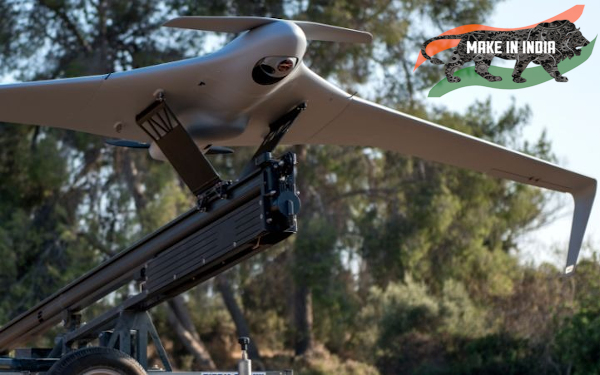Once again Indian security forces after intense fire exchanges killed four terrorists in Jammu and Kashmir, highlighting the need for higher automation in activities like Intelligence, Surveillance and Reconnaissance (ISR) and Unmanned Aerial Vehicles (UAVs) especially for a real-time tactical operation. Aerial systems like UAVs or drones are known to be most cost effective solutions and have potent lethality, when weaponized.
Each of the Armed Forces services have their own UAV arms operational for last two decades, as the UAVs had already evolved as future warfare technology world over in 1990’s itself, especially in the asymmetric warfare.
A UAV can range from MALE (Medium altitude Long Endurance) which can be in air for whole day/night operations, to smaller versions in the category of Mini/Micro or Nano drones. However, the drone technology in use by three services since 1990s has been imported, though expensive but highly reliable aerial bodies.
While the Defence Research and Development Organisation (DRDO) has been trying to indigenize these, the private sector UAV industry has been growing. Unfortunately the evolution of technology has been restricted due to ambiguity in implementation of Drone Regulations promulgated by Airport Authority of India (AAI).
MSMEs in drone manufacturing have found the going difficult and with the pandemic melt down of the manufacturing in India, may require impetus more than ever to remain commercially viable.
Time to share some projects with the private sector, especially MSMEs
As has been reported last week by Financial Express Online, in a letter to the Ministry of Defence (MoD) Society of Indian Defence Manufacturers (SIDM) has requested for a directive to be issued to the DRDO, OFB, DPSUs and the Services to prepare a list of projects that can shared with the private sector companies and the MSMEs.
DRDOs Indigenization of UAVs
DRDO’s long range multi-mission drone, Rustom-2 has been under development since 2011, even after realizing multiple airframes and Design Validation Flights (DVF) by 2017 itself, there have been delays to meet the User’s requirements. As per CAG report of 2018, the non-availability of critical UAV system has adversely affected the aerial surveillance capability of the Indian Army.
The Rustom-2 UAV was a follow up of previous 2009 project version called Rustom-1, which was a composite fiber material 800 kg class Short Range Remotely Piloted Aircraft System (SR-RPAS. During the long project development phase, DRDO planned various up-gradations like Automatic Take-off & Landing (ATOL), Synthetic Aperture Radar (SAR) and Store carrying capability. However, the Rustom-1 service, and the knowledge and learnings gained could only be translated to consequent UAV projects and was not inducted by the Services.
In the mini UAVs category, Netra is a Quadcopter developed by DRDO with Private industry Partnership and could be supplied to Police and Para military services, even Indian Army exploited these drones but technological advancement pushed for upgradation of these miniUAVS.
Unmanned Combat Aerial Vehicles (UCAVs)
UCAVs are UAVs capable to launch missiles, bombs and precision-guided munition. UCAVs are effectively used world over for Search and Attack role, safeguarding own soldier’s from risks. However, due to restrictions in Explosive Ordnance handling by commercial agencies, the design and development of these have been limited in India. The Autonomous Unmanned Research Aircraft (AURA) project launched by DRDO shall form the basis of indigenous UCAV in the future. India’s first weaponized drone was undertaken by National Security Guards (NSG) in 2018. As already reported earlier by Financial Express Online, a private MSME completed the successful development and subsequent manufacture trials of ‘Kamikaze’ explosive laden mini-Quadcopter drones. However, due to complicated procurement procedures has not been inducted yet.
Overall, the armed forces are still dependent on import of UAVs for operational missions, and is spending dollars for maintenance like spares, AMCs signed with the OEMs etc. as India has not been able to manufacture any indigenous UAVs.
“To give a push to the Make in India initiative, now is the time the MoD can balance its investments in DRDO UAVs/UCAVs and private MSMEs. The private sector in Defence has a highly skilled manpower available without any work in hand and they need to be given work to survive,” stated an industry source.
Source: FE
Image Courtesy: Times of Israel
You may also like
-
IAF Aircraft Set Course For Exercise Eastern Bridge VII At Oman
-
IAF Set To Host The Indian Defence Aviation Exposition-II At Jodhpur
-
Defence Secretary to co-chair 5th India-Philippines Joint Defence Cooperation Committee meeting in Manila
-
Simultaneous Launch Of ‘malpe And Mulki’, Fourth And Fifth Ships Of Asw Swc (Csl) Project
-
Aatmanirbharta in Defence: MoD signs Contract with HAL for 240 AL-31FP Aero Engines for Su-30MKI Aircraft
